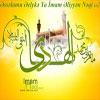
"He it is Who appointed the Sun a splendour and the Moon a light and measured for her stages, that ye might know the number of the years, and the reckoning. Allah created not (all) that save in truth. He detaileth the revelations for people who have knowledge." Qur’an (10:5)
"And We appoint the night and the day two portents. Then We make dark the portent of the night, and We make the portent of the day sight-giving, that ye may seek bounty from your Lord, and that ye may know the computation of the years, and the reckoning; and everything have We expounded with a clear expounding." Qur’an (17:12)
The Universality of Islam can be established by referring to the Qur’an, as it speaks about heavenly bodies. Focusing on the Solar system, the Creator tells in the Qur’an that: "He created the Sun and the Moon, so we learn how to enumerate the years and reckoning."
Thus, the alteration of the day and the night and the seasons of the year must all be in conformity with Allah's plan. In nature, the light that is reflected on the Moon depends on the rays of the Sun's light. Mathematically, there must be a linear correlation between the Lunar and the Solar years, or: y = mx + b
Where: y: dependent variable - Lunar (Hijri) year, x: independent variable - Solar (Gregorian) year, and, b, m: constants.
In the chapter of the Cave, Allah gives m = 309/300 = 1.03 (the slope).
Quran’s chapter of the Elephant marked the birthday of the Prophet - which corresponded to 571 A.D (the intercept).
Knowing that the Prophet migrated from Mecca to Medina at the age of 53, one can determine b = - 639. Thus:
y = 1.03x - 639
Example: put x = 2008 into this equation to get 1429.
Proof: The author of the Qur’an is none but Allah - the exalted Creator.
The Prophet Muhammad could never make such a discovery, given the fact that illiteracy was prevailing in the Arabia Peninsula at his time. In the city of Mecca, where he was born, people were either wood cutters, or shepherd, or merchants. A few were poets. But, none was expert in Physics or Astrology. It was only in the past century when man put his step on the Moon, and learned that its mean distance from the planet Earth is 384,400 Km.
It is pertinent to cite another wondrous revelation that captured the attention of a number of disbelievers and made them return to Islam. Here is the verse:
"The hour drew nigh and the moon was rent in twain." Qur’an (54:1)
Therefore it is important to stress that the Muslims are not Moon worshippers. Unfortunately, this is a stereotype which is very prevalent in the Western media to portray Islam with a negative brush. Islam is the true religion which the Creator has sent to the entire humanity. The Muslims' motto is: the One Creator Who has sent the one true message to the one human family.
According to some tradition, Lunar and Solar eclipses in the month of Ramadhan may herald the coming of the Mahdi. Leaving aside the birth of the tailed comet Helley for other studies, the 1981 and 1982 Lunar and Solar Eclipses in the month Ramadhan have already occurred. But, their occurrence was in the reverse order of what another more authentic Hadith stipulates:
The author of \'eqdud-durar\' in section one, chapter four narrates from \'al-fatan\' of hafiz abu-abdullah na\'eem-ibn-hemmad and he, from yazid-ibn-khalil asadi who said:
\'I was in the presence of Imam Muhammad Baqir (A.S). He mentioned two of the signs which would occur before the emergence of Mahdi and which have not yet been witnessed (right from the time of fall of Adam till now). One sign is this that there shall an eclipse of the Sun on 15th of Ramadhan and the Moon too shall be eclipsed at the end of Ramadhan.
A person said: \'O son of messenger of Allah! It is not as you say. Rather the Sun will be eclipsed at the end of the month of Ramadhan and the Moon will be eclipsed during the middle of the month. Imam Baqir (A.S) said: the One who says these words knows better (than you) that right from the time of Adam\'s fall till today these two signs have not occurred.
The author of es\'aaf-ul-raghaben\' too has narrated the same tradition.
source : tebyan













